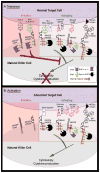Natural killer cells and cancer: regulation by the killer cell Ig-like receptors (KIR)
- PMID: 19923897
- PMCID: PMC2825280
- DOI: 10.4161/cbt.8.23.10455
Natural killer cells and cancer: regulation by the killer cell Ig-like receptors (KIR)
Abstract
Natural killer (NK) cells are innate immune effector cells that make up approximately 10-15% of the peripheral blood lymphocytes in humans and are primarily involved in immunosurveillance to eliminate transformed and virally-infected cells. They were originally defined by their ability to spontaneously eliminate rare cells lacking expression of class I major histocompatibility complex (MHC-I) self molecules, which is commonly referred to as "missing self" recognition. The molecular basis for missing self recognition emerges from the expression of MHC-I-specific inhibitory receptors on the NK cell surface that tolerize NK cells toward normal MHC-I-expressing cells. By lacking inhibitory receptor ligands, tumor cells or virus-infected cells that have down-modulated surface MHC-I expression become susceptible to attack by NK cells. Killer cell Ig-like receptors (KIR; CD158) constitute a family of MHC-I binding receptors that plays a major role in regulating the activation thresholds of NK cells and some T cells in humans. Here, we review the multiple levels of KIR diversity that contribute to the generation of a highly varied NK cell repertoire and explain how this diversity can influence susceptibility to a variety of diseases, including cancer. We further describe strategies by which KIR can be manipulated therapeutically to treat cancer, through the exploitation of KIR/MHC-I ligand mismatch to potentiate hematopoietic stem cell transplantation and the use of KIR blockade to enhance tumor cell killing.
Figures


Similar articles
-
Breaking tolerance to self, circulating natural killer cells expressing inhibitory KIR for non-self HLA exhibit effector function after T cell-depleted allogeneic hematopoietic cell transplantation.Blood. 2009 Apr 16;113(16):3875-84. doi: 10.1182/blood-2008-09-177055. Epub 2009 Jan 28. Blood. 2009. PMID: 19179302 Free PMC article.
-
Hierarchy of the human natural killer cell response is determined by class and quantity of inhibitory receptors for self-HLA-B and HLA-C ligands.J Immunol. 2007 Nov 1;179(9):5977-89. doi: 10.4049/jimmunol.179.9.5977. J Immunol. 2007. PMID: 17947671
-
KIR receptor-ligand incompatibility predicts killing of osteosarcoma cell lines by allogeneic NK cells.Pediatr Blood Cancer. 2010 Dec 15;55(7):1300-5. doi: 10.1002/pbc.22665. Pediatr Blood Cancer. 2010. PMID: 20981688 Free PMC article.
-
The impact of variation at the KIR gene cluster on human disease.Curr Top Microbiol Immunol. 2006;298:225-57. doi: 10.1007/3-540-27743-9_12. Curr Top Microbiol Immunol. 2006. PMID: 16329188 Review.
-
Killer immunoglobulin-like receptors and tumor immunity.Cancer Immunol Res. 2014 Feb;2(2):99-104. doi: 10.1158/2326-6066.CIR-13-0219. Cancer Immunol Res. 2014. PMID: 24592397 Free PMC article. Review.
Cited by
-
Therapeutic avenues for γδ T cells in cancer.J Immunother Cancer. 2023 Nov 24;11(11):e007955. doi: 10.1136/jitc-2023-007955. J Immunother Cancer. 2023. PMID: 38007241 Free PMC article. Review.
-
Molecular-scale spatio-chemical control of the activating-inhibitory signal integration in NK cells.Sci Adv. 2021 Jun 11;7(24):eabc1640. doi: 10.1126/sciadv.abc1640. Print 2021 Jun. Sci Adv. 2021. PMID: 34117052 Free PMC article.
-
Highly activated and expanded natural killer cells for multiple myeloma immunotherapy.Haematologica. 2012 Sep;97(9):1348-56. doi: 10.3324/haematol.2011.056747. Epub 2012 Mar 14. Haematologica. 2012. PMID: 22419581 Free PMC article.
-
Tributyltin and dibutyltin alter secretion of tumor necrosis factor alpha from human natural killer cells and a mixture of T cells and natural killer cells.J Appl Toxicol. 2013 Jun;33(6):503-10. doi: 10.1002/jat.2822. Epub 2012 Oct 10. J Appl Toxicol. 2013. PMID: 23047847 Free PMC article.
-
The favorable role of homozygosity for killer immunoglobulin-like receptor (KIR) A haplotype in patients with advanced-stage classic Hodgkin lymphoma.J Hematol Oncol. 2016 Mar 16;9:26. doi: 10.1186/s13045-016-0255-4. J Hematol Oncol. 2016. PMID: 26983546 Free PMC article.
References
-
- Biron CA. Activation and function of natural killer cell responses during viral infections. Curr Opin Immunol. 1997;9:24–34. - PubMed
-
- Wu J, Lanier LL. Natural killer cells and cancer. Adv Cancer Res. 2003;90:127–56. - PubMed
-
- Smyth MJ, Cretney E, Kelly JM, Westwood JA, Street SE, Yagita H, et al. Activation of NK cell cytotoxicity. Mol Immunol. 2005;42:501–10. - PubMed
Publication types
MeSH terms
Substances
Grants and funding
LinkOut - more resources
Full Text Sources
Other Literature Sources
Research Materials
